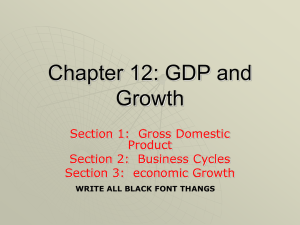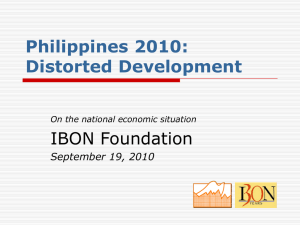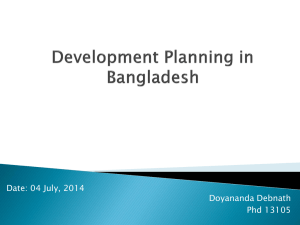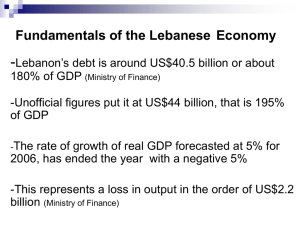5) Medium Term Plan – 2011 to 2015
advertisement
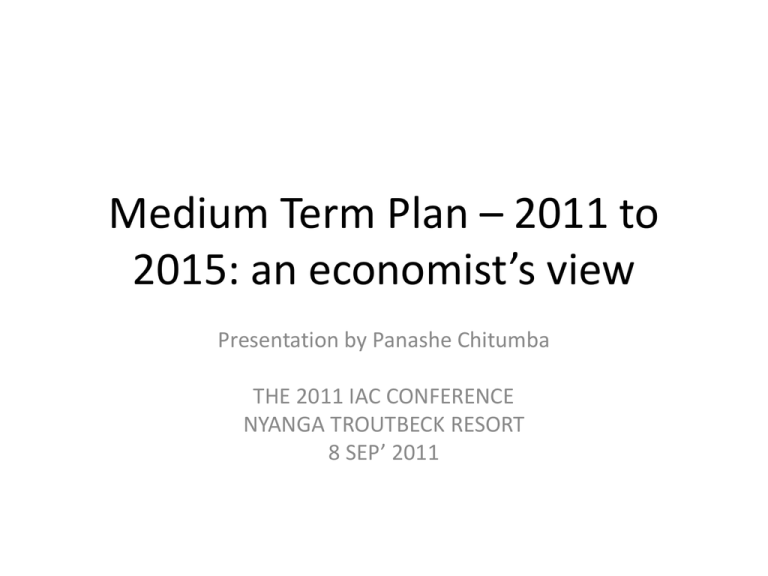
Medium Term Plan – 2011 to 2015: an economist’s view Presentation by Panashe Chitumba THE 2011 IAC CONFERENCE NYANGA TROUTBECK RESORT 8 SEP’ 2011 -Internal factors External Factors ZIMBABWE SITUATIONAL ANALYSIS – AS WE EMERGE FROM HYPERINFLATION CRISIS Positive Factors Negative Factors STRENGTHS WEAKNESSES -Natural resources endowments -High literacy levels (90%) -Peace loving -Disharmony in policy e.g. economic empowerment -Low productive capacity utilization and low GDP -Infrastructural decay - poverty OPPORTUNITIES THREATS -Firming international commodity prices -Increased investment flows into Africa -Accessibility of global financial markets & capital -New emerging market segments (BRICS) -Global economic recession -International negative publicity -Competition from other stronger economies (cheaper imports), - Global Warming and climatic changes. PURPOSE OF NATIONAL STRATEGIC PLANNING •Laying the direction for economy to take •Spelling out the national priorities •Setting national goals for development •Fostering unity of purpose in economic development •Guiding investment and development partners National Vision building Medium Term Planning; STERP II Fiscal & Monetary Policies; STERP Corporate & Individual Plans & Budgets IMMEDIATE SELECTED ISSUES REQUIRING ATTENTION DURING 2011 TO 2015 SETTING THE RIGHT NATIONAL GOALS IN LINE WITH OUR CAPACITY TO WORK TOWARDS THEIR ACHIEVEMENT. • capital raising initiatives • external debt restructuring • macro economic stability • policy certainty • business confidence • capacity utilisation poverty reduction • social services affordability & accessibility • economic empowerment •Reduced donor dependency • infrastructure development • sustaining the development momentum LONG TERM MEDIUM TERM PLAN GOALS : DURING 20112015 • TRANSFORM THE ECONOMY • REDUCE POVERTY • CREATE JOBS • MAINTAIN MACROECONOMIC STABILITY • RESTORE PRODUCTIVE CAPACITY • BUILD UPON THE GAINS FROM STERP • OUTLINING THE NATIONAL • • PRIORITIES THESE HAVE ALSO BEEN SPELT OUT • IN: - STERP II - MTP - NATIONAL BUDGET STATEMENTS - MONETARY STATEMENTS • • • • • • INFRASTRUCTURE DEVELOPMENT EMPLOYMENT CREATION HUMAN CENTRED DEVELOPMENT ENTREPRENUERSHIP DEVELOPMENT MACROECONOMIC STABILITY ICT AND SCIENCE & TECHNOLOGY DEVELOPMENT GOOD GOVERNANCE INVESTMENT REGULATION, COORDINATION AND PROMOTION RESOURCE UTILISATION AND POVERTY REDUCTION GENDER MAINSTREAMING INTO ECONOMIC ACTIVITIES IMPLENTATION TARGETS All systems complementary • • • • • • • • • • Average annual GDP growth rate of 7.1%; Single-digit annual inflation; Interest rates that promotes savings and investment; Current Account Deficit of ≤ 5 percent of GDP by 2015; Average annual jobs creation rate of 6 %; Sustained Poverty Reduction in line with MDGs targets; Foreign Exchange Reserves of at least 3 months import cover by 2015; Double-digit savings and investment ratios of around 20 percent of GDP by 2015; Budget deficit of less than 5 percent of GDP by 2015; Reduce sovereign debt to at least 60 percent of GDP by 2015. SHORTCOMINGS OF PAST BLUE PRINTS? WHAT ARE WE DOING DIFFERENTLY THIS TIME AROUND? • ZIMBABWE HAS BEEN REOWNED FOR DRAWING UP GOOD PLANS/POLICIES THAT FAIL AT IMPLEMENTATION STAGE DUE TO, INTER-ALIA: – INADEQUATE FUNDING & UNREALISTIC FINANCING SOURCES – RESPONSIBILITY & ACCOUNTABILITY CHALLENGES – CHECKS & BALANCES – UNREALISTIC TARGETS (NOT ALIGNED TO POLICIES e.g. targeting single digit inflation when creating credit in excess of economy’s capacity), – LACK OF TECHNICAL CAPACITY, – POLICY INCOHERENCE, – WEAK MONITORING AND EVALUATION PROCESSES FUNDING THE MEDIUM TERM PLAN OUR GDP APPROX. US$ 9 BN? WE “EAT” > 90% OF IT (LEAVING LITTLE TO INVEST) . SHOULDN’T WE EXPLORE MORE FUNDING OPTIONS? • APPROX USD 9.2 BILLION IS REQUIRED TO FUND THE INVESTMENTS UNDER THE MTP • SOURCE – LARGELY DOMESTIC • WHAT IS THE CAPACITY OF THE DOMESTIC MARKET? • WHAT OTHER OPTIONS DO WE NEED TO PURSUE? FDI • WE ARE NOW A PLAYER IN A GLOBAL VILLAGE. • WHAT SHOULD WE DO IN ORDER TO ATTRACT FUNDING FROM THE GLOBAL CAPITAL MARKETS? • DEBT STRATEGY KEY TO ATTRACTING INTERNATIONAL CAPITAL RELEVANT LESSONS? SAVINGS MOBILISATION: • Economic growth is easily sustained in countries with high savings rates. For example China (with savings of 54% of GDP), India (35%), Russia (23%), South Africa & Brazil ( 15%) have recorded phenomenon growth due to high savings rates. Countries with low saving rates such as USA (10% of GDP) are struggling to sustain growth (Standard & Poors 2009). • Zimbabwe’s savings rate was estimated at -4% in 2009 (Ministry of Finance). INFRASTRUCTURE: • Most infrastructure projects are long term in nature and requires low interest rates. Most commercial banks do not fund such projects. In China in the 1990’s, the Government set up three developmental banks namely ICBC, China Agricultural Bank and China Construction Bank. These banks undertook infrastructure projects amounting to over USD 100 billion every year. These capital projects have allowed the Chinese economy to sustain its rapid growth (South Asia Analysis Group, 27 April 2010). RELEVANT LESSONS?....CONT’D CREDIT AVAILABILITY (LOCAL CAPACITY TO DRIVE MTP GOALS):? • Most developmental banks in the Sub Sahara Africa are failing to operate efficiently mainly due to undercapitalization. According to the World Bank, Africa requires over US$480 billion for capitalization but their economies are not able to sustain such projects. • African economies are not able to efficiently un lock the huge growth potential that exists. • In Zimbabwe, the IDBZ is also not adequately funded. ALTERNATIVE FUNDING SOURCES – MISSED OPPORTUNITIES? • ZIMBABWE HAS JOINED THE COMPETITION FOR GLOBAL INVESTMENT FLOWS •OVER THE PAST TWO DECADES, FOREIGN DIRECT INVESTMENT (FDI) HAS BECOME A VITAL SOURCE OF ECONOMIC DEVELOPMENT FOR THE AFRICAN CONTINENT. •WITH AN INCREASE FROM APPROX US$ 9 BN IN 2000 TO US$ 18BN IN 2004 AND US$ 88 BN IN 2008 FDI HAS BECOME A MAJOR COURCE OF FINANCE FOR AFRICA. ZIMBABWE AS A COMPETITIVE INVESTMENT DESTINATION. How do we score? • PROSPECTIVE INVESTORS COMPARE THE FOLLOWING FACTORS ACROSS MARKETS: – Political and macroeconomic stability; – Growth levels & market size; – Availability of natural resources; – Infrastructure development; – Governance record; – Regulatory environments & efficiency; and – Investment promotion strategies (e.g. incentives). IMPERATIVE TO ALLOW SOME FLEXIBILITY IN NATIONAL STRATEGIC PLANNING • Dealing with unforeseen developments (world economic crisis – double dip) • Trading currency volatility – what is our alternate plan when the US dollar strengthens and renders our exports uncompetitive • Funding constraints – delays in project/programme take-off • Capacity constraints – e.g. technical; data; implementation & monitoring • Engaging international development partners & financiers ROLE CLARITY • Development drivers - private sector investment • Enablers – government, through policy framework • Success factors: – Funding – Manpower (capacity issues) – Infrastructure (energy, water, transport, etc) • Lets avoid surprises – every year we must measure our progress or lack of it (and institute corrective action) • Expected outcomes – poverty reduction through employment creation and entrepreneurial development CONCUDING REMARKS • COMPREHENSIVE PLAN • DEVELOPMENT DIRECTION LAID OUT FOR ALL (SIFT FOR OPPORTUNITIES) • TARGETS ARE AND SOME ARE ACHIEVABLE. CRITICAL FACTORS: • ROLE CLARITY IS MAINTAINED • CONDUCIVE ENVIRONMENT FOR INVESTMENT IS SET • ACCOUNTABILITY IS ENFORCED • MONITORING & EVALUATION STRENGTHENS BUY-IN • REAL TEST IS ON PLAN EXECUTION, MONITORING & REVIEW




